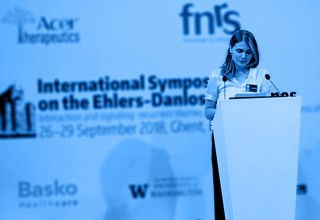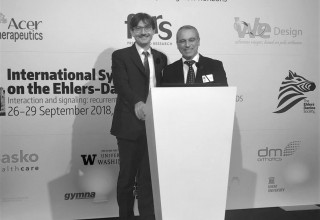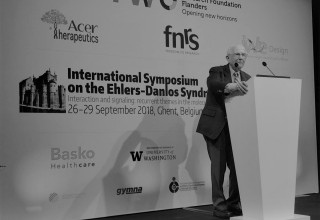International Symposium Convenes to Address Ehlers-Danlos Syndromes and Hypermobility Spectrum Disorders

GHENT, Belgium, September 28, 2018 (Newswire.com) - With over 275 scientists, clinicians and patient organizations from around the world, The 2018 International Symposium on the Ehlers-Danlos Syndromes is bringing together the brightest minds in Ehlers-Danlos (EDS) research and clinical management to tackle some of the most pressing questions involving EDS, hypermobility spectrum disorders (HSD) — and myriad of associated symptoms and related conditions.
"We welcome old colleagues and consortium members to beautiful Ghent, a hidden vibrant city full of charm — and we are equally delighted to see all the fresh new faces here dedicated to helping people living with EDS and HSD,” stated Professor Fransiska Malfait, co-chair of the symposium and co-chair of The Ehlers-Danlos Society’s medical board during her opening address. “This will be a truly interdisciplinary meeting.”
This symposium represents the collective efforts of hundreds of researchers, clinicians and patient experts throughout the world to address these complex, multi-systemic, poorly understood group of disorders.
Lara Bloom, International Executive Director for the Ehlers-Danlos Society
International collaboration and interdisciplinary research builds hopes for advancement
“This symposium represents the collective efforts of hundreds of researchers, clinicians and patient experts throughout the world to address these complex, multi-systemic, poorly understood group of disorders,” states Lara Bloom, international executive director of The Ehlers-Danlos Society.
This year’s symposium brings together an international panel of leading clinicians, clinical and basic scientists — and patient support group representatives — to foster multidisciplinary collaboration on the rapidly expanding array of research into the Ehlers-Danlos syndromes and associated pathologies.”We are energetically seeking to accelerate recent clinical advances and delve deeper into the molecular and pathogenic mechanisms underlying EDS and related syndromes,” adds Clair Francomano, chair of The Ehlers-Danlos Society’s medical board and director of The Ehlers-Danlos Society Center for Clinical Care and Research at the Harvey Institute of Human Genetics, Greater Baltimore Medical Center.
Presentations will include the molecular etiology of these disorders, the biochemical abnormalities produced by the underlying mutations affecting genes involved in connective tissue homeostasis, the clinical consequences of these mutations and the latest advances in therapies, including medical, surgical and physiotherapeutic treatments, and the effects of these interventions on the natural history of the disease.
Ultimately, the symposium will provide the forum necessary for these experts to discuss potential implications of current research and clinical findings, and plan the research necessary to improve the lives of those with EDS and HSD.
The momentum builds as growing international collaboration accelerates understanding
“Our momentum is building,” states Bloom. “Our 2016 symposium in New York saw both the formalisation of the International Consortium on Ehlers-Danlos and Related Disorders and the launch of The Ehlers-Danlos Society into a global catalyst for research, awareness, education and support.”
“Collaboration of this scale is so powerful and we are fortunate to have the opportunity to work alongside our international colleagues as we push forth to learn more about these multisystemic, complex genetic disorders,” added Dr. Alan Hakim, education director for the Ehlers-Danlos Society. “The previous symposium was a huge success in advancing our understanding of the Ehlers-Danlos syndromes and I have no doubt that we will see similar, groundbreaking progress from this event.”
The previous symposium served as a catalyst for the publication of a groundbreaking comprehensive special edition of the American Journal of Medical Genetics. Comprised of 18 original papers, the supplement, Volume 175, Issue 1, Part C: The Ehlers‐Danlos Syndromes: Reports from the International Consortium on the Ehlers‐Danlos Syndromes, includes the first new update to the classification of the Ehlers-Danlos syndromes in more than two decades, increased the number of named EDS types from six to 13, introduced the newly described hypermobility spectrum disorders and established management and care guidelines for all types of EDS, as well as many of the comorbid conditions sometimes seen in conjunction with EDS.
Ghent 2018 — energy into action
The 2018 International Symposium on the Ehlers-Danlos Syndromes lasted four days, 26 - 29 September, and included current research and poster presentations from experts in the field. At the conclusion of the symposium, a Patient Day will be held on Sunday, 30 September, to allow patients to learn about managing their condition from these world-renowned EDS experts.
“We are extremely proud to host the International Consortium for the second time, this time with the expert team at the University of Ghent, and reassert our commitment to research into the Ehlers-Danlos syndromes,” states Lara Bloom, international executive director for the Ehlers-Danlos Society. “These researchers, clinicians and scientists hold the key to saving and improving the lives of all those living with EDS, HSD and the associated symptoms and conditions affecting so many throughout the world. It is an honor to support this event.”
ABOUT THE EHLERS-DANLOS SOCIETY
The Ehlers-Danlos Society is a global community of patients, caregivers, healthcare professionals and supporters dedicated to saving and improving the lives of those affected by the Ehlers-Danlos syndromes, hypermobility spectrum disorders and related conditions.
A 501(c)(3) nonprofit organization with offices in the U.S. and the U.K., we support collaborative research, education, advocacy, community-building and care for people with EDS and HSD.
The Ehlers-Danlos Society seeks to grow worldwide awareness — and a better quality of life for all who suffer from these conditions. Research is at the center of what we do so that one day we will have a cure.
ABOUT THE EHLERS-DANLOS SYNDROMES AND HYPERMOBILITY SPECTRUM DISORDERS
The Ehlers-Danlos syndromes (EDS) are a group of 14 heritable connective tissue gene disorders that produce a spectrum of complex problems across multiple systems of the body. The physical characteristics that are common to all types of EDS include hypermobile joints, skin hyperextensibility and tissue fragility. EDS are known to affect more than one in 5,000 men and women of every race and ethnicity.
Each person’s case of Ehlers-Danlos syndrome is unique. Severity may range dramatically, even within families. Prognosis depends on the type of Ehlers-Danlos syndrome and the individual.
Hypermobile Ehlers-Danlos Syndrome (hEDS)
Hypermobile EDS (hEDS) typically begins with extreme joint hypermobility, joints which can stretch beyond normal limits; a propensity for sprains, strains, subluxations and dislocations; pain, often in lower limbs, and with fine motor or repetitive tasks; and easy fatigability.
Although each person with hEDS faces their own set of problems out of the wide range of possible effects, hEDS generally evolves over time. The initial “hypermobility” phase may involve the ability to hyperextend various body parts to extremes normally attributed to contortionists, gymnasts or elite dancers. Over time, the extreme hypermobility and connective tissue instability of hypermobile EDS may lead to permanent injuries. The “pain” phase involves widespread and worsening pain and headache; pelvic pain in women; and worsened fatigue. The “stiffness” phase seen in some adults and in the elderly results in general reduction in joint hypermobility; significant losses in functionality because of disabling pain and fatigue; and increased limitations, due to reduced muscle mass and weakness, prior injuries and arthritis.
While certain features of hypermobile EDS are not yet in the diagnostic criteria — as more research is needed to prove causation and the relationships between the hEDS and potential comorbidities — clinical descriptions of hEDS have expanded beyond joint hypermobility to include: chronic pain and fatigue, gastrointestinal disorders, neurological issues, dysautonomia and anxiety. As of this time, hypermobile EDS has no identified distinctive cause.
Hypermobility Spectrum Disorders (HSD)
The hypermobility spectrum disorders (HSD) describe patients with symptomatic joint hypermobility not corresponding to other known conditions. The spectrum of HSD ranges from secondary musculoskeletal manifestations and a simplified categorization of genetic syndromes featuring joint hypermobility.
Vascular Ehlers-Danlos Syndrome (vEDS)
Life expectancy can be significantly shortened for those with the Vascular Ehlers-Danlos syndrome (vEDS) due to the potential for organ and/or blood vessel rupture. While significantly diminished life expectancy is not usually a factor in the other types, quality of life can be severely affected by chronic pain, disability and myriad comorbidities. There are no cures for the Ehlers-Danlos syndromes, but there are treatments which address many symptoms and preventative measures that may help slow their progression.
Source: The Ehlers-Danlos Society



